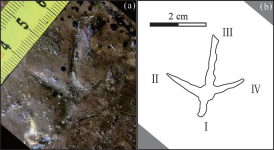albertonykus
Well-known member
Zhang, Y., Y. Sun, J. Chen, W. Cui, S. Chen, and Z. Wang (2024)
A new avian footprint from the Lower Cretaceous in Zhucheng, Shandong Province
Geological Review 70: 2024010011
doi: 10.16509/j.georeview.2024.01.022
There is a complete avian footprint (ZDRC. F3) preserved in the Lower Cretaceous at the Zhangzhuhewan dinosaur footprint site in Zhucheng, Shandong Province. It had been briefly described and classified as the Jindongornipes sp. This article conducts a detailed systematic paleontological study of the footprint, and preliminary reconstruct the paleoenvironment and paleogeography of the Zhangzhuhewan dinosaur footprint site.
Methods: A detailed feature description of the avian footprint in Zhangzhuhewan dinosaur footprint site was conducted using observation and measurement methods, and their morphological characteristics and related parameters were compared with the footprint of the Jindongornipodidae, analyzing the similarities and differences between the two. Based on regional geology, preservation characteristics of dinosaur and avian footprints, and layer structures, the paleogeography and paleoclimate of their survival period are reconstructed, and the formation environment and process of the avian footprint are speculated.
Results: There are significant differences in the footprints between ZDRC.F3 and Jindongornipodidae: ① ZDRC.F3 is a small footprint with a width of 2.9 cm, less than half of the bird family footprint in Jindongornipodidae, and not within the range of 6.5~ 7.5 cm in width; ② The digit Ⅱ is slightly longer than the digit Ⅳ, which does not conform to the characteristic of the Jindongornipodidae that the digit Ⅱ is shorter than the digit Ⅳ. ZDRC.F3 was removed from Jindongornipodidae and a new genus and species of Zhuchengornipes exquisitus gen. et sp. nov was established. The regional geology and characteristics of dinosaur and avian footprints and mud cracks indicate that Zhangzhuhewan dinosaur footprint site is located at the edge of a giant lake basin. The slope of the lake edge is small, and the lake water is shallow at Zhangzhuhewan site. During the dry season, the evaporation of the lake water exceeds the precipitation. Intermittent droughts occur at the edge of the lake, resulting in large areas of lakeside beaches exposed to the air. At that time, bird living nearby left footprints on the lakeside.
Conclusions: Zhuchengornipes inquisitus gen. et sp. nov. is a new type of avian footprint that differs from the avian footprints previously discovered and may have been created by shorebirds. The avian footprint was formed in the coastal and shallow lake environment of arid climate in the Early Cretaceous.
A new avian footprint from the Lower Cretaceous in Zhucheng, Shandong Province
Geological Review 70: 2024010011
doi: 10.16509/j.georeview.2024.01.022
There is a complete avian footprint (ZDRC. F3) preserved in the Lower Cretaceous at the Zhangzhuhewan dinosaur footprint site in Zhucheng, Shandong Province. It had been briefly described and classified as the Jindongornipes sp. This article conducts a detailed systematic paleontological study of the footprint, and preliminary reconstruct the paleoenvironment and paleogeography of the Zhangzhuhewan dinosaur footprint site.
Methods: A detailed feature description of the avian footprint in Zhangzhuhewan dinosaur footprint site was conducted using observation and measurement methods, and their morphological characteristics and related parameters were compared with the footprint of the Jindongornipodidae, analyzing the similarities and differences between the two. Based on regional geology, preservation characteristics of dinosaur and avian footprints, and layer structures, the paleogeography and paleoclimate of their survival period are reconstructed, and the formation environment and process of the avian footprint are speculated.
Results: There are significant differences in the footprints between ZDRC.F3 and Jindongornipodidae: ① ZDRC.F3 is a small footprint with a width of 2.9 cm, less than half of the bird family footprint in Jindongornipodidae, and not within the range of 6.5~ 7.5 cm in width; ② The digit Ⅱ is slightly longer than the digit Ⅳ, which does not conform to the characteristic of the Jindongornipodidae that the digit Ⅱ is shorter than the digit Ⅳ. ZDRC.F3 was removed from Jindongornipodidae and a new genus and species of Zhuchengornipes exquisitus gen. et sp. nov was established. The regional geology and characteristics of dinosaur and avian footprints and mud cracks indicate that Zhangzhuhewan dinosaur footprint site is located at the edge of a giant lake basin. The slope of the lake edge is small, and the lake water is shallow at Zhangzhuhewan site. During the dry season, the evaporation of the lake water exceeds the precipitation. Intermittent droughts occur at the edge of the lake, resulting in large areas of lakeside beaches exposed to the air. At that time, bird living nearby left footprints on the lakeside.
Conclusions: Zhuchengornipes inquisitus gen. et sp. nov. is a new type of avian footprint that differs from the avian footprints previously discovered and may have been created by shorebirds. The avian footprint was formed in the coastal and shallow lake environment of arid climate in the Early Cretaceous.
Last edited:





